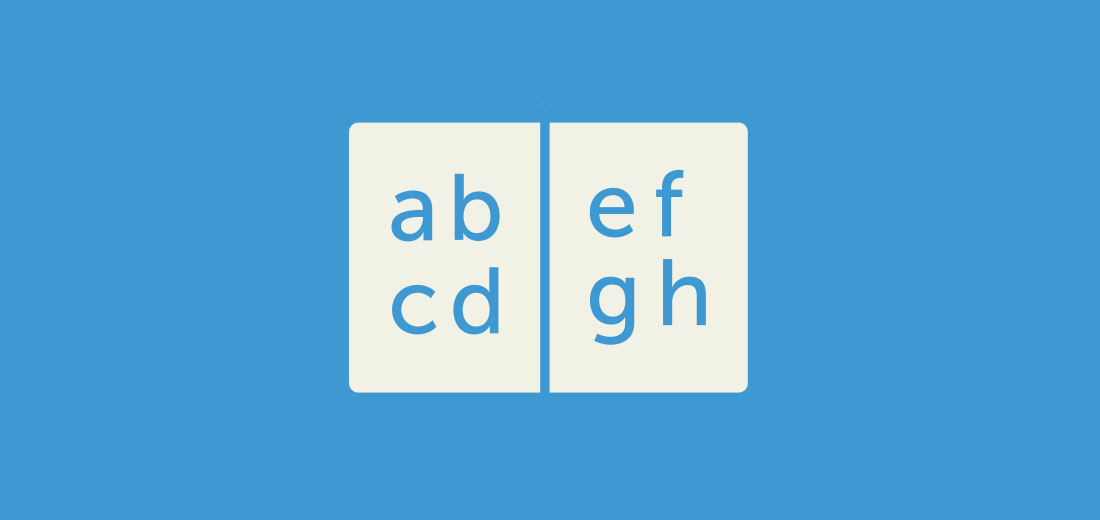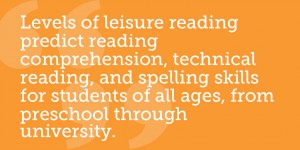
How do students learn to read and write? What are effective ways to help struggling readers?
The ability to read is essential for daily life. Reading is also a prerequisite for participating fully in the education system, and poor reading skills can hold students back throughout their academic careers.[i] Three-quarters of children who are reading below grade level at the end of third grade continue to struggle with reading throughout secondary school.[ii] These children are more likely to have behavioral and social problems in later grades, and are less likely to graduate from high school.[ii]
Skillful reading comprehension requires the ability to read words (word recognition) and to understand what those words mean (language comprehension).[iii] Comprehension is rooted in early oral language experiences, nurtured by a child’s home literacy environment and primary language.[xx] Early readers develop the ability to read words in stages.[iv] First, children learn letters and begin to connect them with sounds (phonemes). Then they start grouping together letters and sounds into morphemes, the smallest units of language (stand-alone words, as well as prefixes and suffixes). Once children can fully connect written words and sounds, a process called decoding, they are able to learn new and more complex words through reading. When word recognition becomes automatic, students become fluent readers and can devote energy to reading comprehension.[v]
The sections below highlight key findings from the research on literacy learning and teaching.

Many children are first exposed to reading when parents and caregivers read to them at an early age. Research shows that the literacy environment in a child’s home, including the quantity and quality of conversations with parents and caregivers, has a significant impact on later language and reading skills.[vi] Beginning as early as the reading of picture books in infancy[iv], caregiver shared reading also builds literacy and helps children develop a positive image of reading as an enjoyable leisure activity. This is important because the more time children spend reading for pleasure, the better their reading skills and academic performance will be.[vii] Levels of leisure reading predict reading comprehension, technical reading, and spelling skills for students of all ages, from preschool through university.[viii]
Some students have difficulty developing literacy skills. Dyslexia or specific reading difficulty is the most common reading-related disability, affecting nearly one in five students in the U.S.[xiv] Research suggests that trouble with phonemic awareness is at the root of dyslexia.[xv] Children with dyslexia can have difficulty learning letters, connecting letters to sounds, sounding out words, recognizing words on sight, and reading smoothly.[viii] The most effective intervention for these children is a combination of letter-sound training and phonemic awareness training (such as phonics instruction).[xiv] However, some children struggle with literacy because they lack foundational language skills. These children have difficulty understanding what they have decoded. The most effective interventions for these children includes building oral language skills and teaching specific reading comprehension strategies.[xxi]
Another group to consider in reading education are the estimated 4.4 million English language learning (ELL) students who are learning not just to read, but to read in a new language.[xvii] Because bilingual and multilingual students acquire oral language and early literacy skills, including vocabulary and syntax (grammar), slower in each language than children who only know one language, they often enter school with fewer of these skills than monolingual children[xxii] and may also demonstrate delayed language comprehension[xxiii]. In addition to focusing on word-level skills, such as word recognition and spelling, instructional ELL programs should support language comprehension.[xviii][xix] With the right amount of language and literacy support at home and in school, ELL students can catch up to their monolingual peers.
Phonemic awareness, the ability to recognize and produce the individual sounds that make up a language, is one of the strongest predictors of a child’s reading ability.[ix] Children who have limited phonemic awareness have trouble identifying the separate sounds within a word, understanding how two words sound alike or different, coming up with words that rhyme, and understanding how sounds blend together to form a word. The related skill, phonics, is the ability to attach sounds to letters and combinations of letters and to understand the rules that govern decoding and spelling. Phonemic awareness and phonics are fundamental building blocks for literacy, and among the most important skills to include in early childhood reading education.[ix]
Phonics instruction is a widely used, highly effective approach for developing phonemic awareness.[ix] However, experts recommend that phonics should be one component of a balanced approach to reading education that incorporates multiple instructional techniques tailored to students’ skill levels.[xi][xii]
 In addition to phonemic awareness and phonics, language comprehension is a second foundational skill for reading. Language comprehension is the ability to gain meaning from what is read, and it includes a combination of several different skills and sets of knowledge. Students must have knowledge of vocabulary and an understanding of the language structures between words and within sentences. They must also have background knowledge on the topic or words, and actively make connections between ideas so they can understand what they read [xiii]. Although language comprehension applied to understanding text is not always fully automatic in the same way as with phonemic awareness (e.g., even able readers slow down when text is difficult), it can be strengthened. For example, to foster vocabulary development, educators can provide opportunities for rich and varied oral dialogue experiences, and encourage students to read independently. They can also broaden students’ understanding of language use through exposure to discussions, and a variety of reading, television, movies, and online videos [xiii].
In addition to phonemic awareness and phonics, language comprehension is a second foundational skill for reading. Language comprehension is the ability to gain meaning from what is read, and it includes a combination of several different skills and sets of knowledge. Students must have knowledge of vocabulary and an understanding of the language structures between words and within sentences. They must also have background knowledge on the topic or words, and actively make connections between ideas so they can understand what they read [xiii]. Although language comprehension applied to understanding text is not always fully automatic in the same way as with phonemic awareness (e.g., even able readers slow down when text is difficult), it can be strengthened. For example, to foster vocabulary development, educators can provide opportunities for rich and varied oral dialogue experiences, and encourage students to read independently. They can also broaden students’ understanding of language use through exposure to discussions, and a variety of reading, television, movies, and online videos [xiii].
As discussed above, a large body of research shows that the most successful programs for teaching beginning readers incorporate phonemic awareness (recognizing individual sounds) and phonics (connecting those sounds to letters and letter combinations).[xxiv] For more advanced readers, teaching other skills like reading comprehension becomes more important.[xxv] For students who struggle with reading disabilities or literacy challenges, early intervention is necessary to ensure they do not continue to fall behind their peers[xxvi]. The Response to Intervention (RTI) model can be used to identify students who are struggling, provide them with appropriate evidence-based interventions, and measure their progress.[xxvii] Students are given increasingly intensive interventions as needed, such as small group and one-on-one supplemental instruction.
Explore Literacy on the Visualization.
Citations
[i] Hernandez, D. J. (2011). Double Jeopardy: How Third-Grade Reading Skills and Poverty Influence High School Graduation. Annie E. Casey Foundation.
[ii] https://www.aecf.org/m/resourcedoc/AECF-Early_Warning_Full_Report-2010.pdf
[iii] Connecting early language and literacy to later reading (dis)abilities: Evidence, theory, and practice, by H. S. Scarborough, in S. B. Newman & D. K. Dickinson (Eds.), 2002, Handbook of early literacy research, p. 98, Copyright 2002, New York, NY: Guilford Press. Reprinted with permission.
[iv] Ehri, L. C. (2005). Learning to read words: Theory, findings, and issues. Scientific Studies of reading, 9(2), 167-188.
Armbruster, B. B., Lehr, F., & Osborn, J. M. (2003). A Child Becomes a Reader: Birth through Preschool. Proven Ideas from Research for Parents.
[v] Murray, M.S. (2016). Word Recognition Skills: One of Two Essential Components of Reading Comprehension. In K.A. Munger (Ed.), Steps to success: Crossing the bridge between literacy research and practice. Geneseo, NY: Open SUNY Textbooks.
[vi] Fletcher, Kathryn L., et al. “Predicting language development in children at risk: The effects of quality and frequency of caregiver reading.” Early Education and Development 19.1 (2008): 89-111.
[vii] Mol, S. E., & Jolles, J. (2014). Reading enjoyment amongst non-leisure readers can affect achievement in secondary school. Frontiers in psychology, 5.
[viii] To Read or Not to Read: A Meta-Analysis of Print Exposure From Infancy to Early Adulthood [Article] Mol SE, Bus AG,PSYCHOL BULL (2011),
[ix] Phonological Skills and Their Role in Learning to Read: A Meta-Analytic Review [Review] Melby-Lervag M, Lyster SAH, Hulme C,PSYCHOL BULL (2012),
Goldenberg, C., Hicks, J., & Lit, I. (2013). Dual language learners: Effective instruction in early childhood. American Educator, 37(2), 26-29.
[x] Hook, P. E., & Jones, S. D. (2002). The importance of automaticity and fluency for efficient reading comprehension. Perspectives, 28(1), 9-14.
[xi] National Reading Panel report. https://www.nichd.nih.gov/publications/pubs/nrp/Pages/smallbook.aspx
[xii] Why What We Teach Depends on When: Grade and Reading Intervention Modality Moderate Effect Size [Article] Suggate SP,DEV PSYCHOL (2010),
[xiii] Murray, M.S. (2016). Language Comprehension Ability: One of Two Essential Components of Reading Comprehension. In K.A. Munger (Ed.), Steps to success: Crossing the bridge between literacy research and practice. Geneseo, NY: Open SUNY Textbooks.
[xiv]Ferrer, E., Shaywitz, B. A., Holahan, J. M., Marchione, K. E., Michaels, R., & Shaywitz, S. E. (2015). Achievement Gap in Reading Is Present as Early as First Grade and Persists through Adolescence. The Journal of pediatrics, 167(5), 1121-1125.
[xv] Reading development subtypes and their early characteristics [Article] [13 different authors], ANN DYSLEXIA (2007),
[xvi] Schneider, W., Roth, E., & Ennemoser, M. (2000). Training phonological skills and letter knowledge in children at risk for dyslexia: A comparison of three kindergarten intervention programs. Journal of Educational Psychology, 92(2), 284.
[xvii] Institute of Education Sciences (2015). English language learners. https://nces.ed.gov/programs/coe/indicator_cgf.asp
Goldenberg, C., Hicks, J., & Lit, I. (2013). Dual language learners: Effective instruction in early childhood. American Educator, 37(2), 26-29.
[xviii] Tembe, J. (2008). Developing literacy in second-language learners: Report of the national literacy panel on language-minority children and youth.
[xix] Murray, M.S. (2016). Language Comprehension Ability: One of Two Essential Components of Reading Comprehension. In K.A. Munger (Ed.), Steps to success: Crossing the bridge between literacy research and practice. Geneseo, NY: Open SUNY Textbooks.
[xx] Niklas, F., & Schneider, W. (2013). Home literacy environment and the beginning of reading and spelling. Contemporary Educational Psychology, 38(1), 40-50.
Lesaux, N. K., Crosson, A. C., Kieffer, M. J., & Pierce, M. (2010). Uneven profiles: Language minority learners’ word reading, vocabulary, and reading comprehension skills. Journal of Applied Developmental Psychology, 31(6), 475-483.
[xxi] Catts, H. W., Adlof, S. M., & Weismer, S. E. (2006). Language deficits in poor comprehenders: A case for the simple view of reading. Journal of Speech, Language, and Hearing Research, 49(2), 278-293.
NICHD National Reading Panel. (2000). Teaching children to read: An evidence-based assessment of the scientific research literature on reading and its implications for reading instruction. Washington DC: U.S. DHHS, PHS, NICHD.
[xxii] Barac, R., Bialystok, E., Castro, D. C., & Sanchez, M. (2014). The cognitive development of young dual language learners: A critical review. Early Childhood Research Quarterly, 29(4), 699-714.
[xxiii] Lesaux, N. K., Crosson, A. C., Kieffer, M. J., & Pierce, M. (2010). Uneven profiles: Language minority learners’ word reading, vocabulary, and reading comprehension skills. Journal of Applied Developmental Psychology, 31(6), 475-483.
[xxiv] Slavin, R. E., Lake, C., Chambers, B., Cheung, A., & Davis, S. (2009). Effective reading programs for the elementary grades: A best-evidence synthesis. Review of Educational Research, 79(4): 1391-1466.
[xxv] Suggate, S. P. (2010). Why what we teach depends on when: Grade and reading intervention modality moderate effect size. Developmental Psychology, 46(6): 1556-1579.
[xxvi] Slavin, R. E., Cheung, A., Groff, C., & Lake, C. (2008). Effective reading programs for middle and high schools: A best‐evidence synthesis. Reading Research Quarterly, 43(3): 290-322.
Brooks, G. (2016). What works for children and young people with literacy difficulties? The effectiveness of intervention schemes, 5th edition. Frensham, UK: Dyslexia-SpLD
[xxvii] Trust.Denton, C. A. (2012). Response to intervention for reading difficulties in the primary grades: Some answers and lingering questions. Journal of Learning Disabilities, 45(3): 232-243.